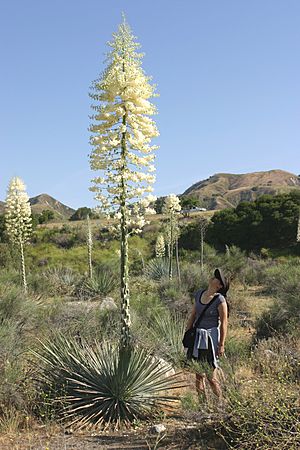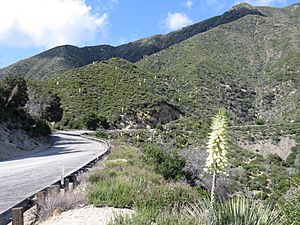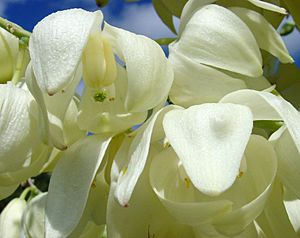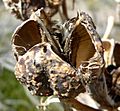Chaparral yucca facts for kids
Quick facts for kids Chaparral yucca |
|
|---|---|
 |
|
| Scientific classification |
The chaparral yucca (scientific name: Hesperoyucca whipplei) is a cool flowering plant. It's also known by fun names like our Lord's candle, Spanish bayonet, Quixote yucca, or foothill yucca. It used to be thought of as a type of Yucca plant, but scientists now know it's a bit different.
You can find this plant growing naturally in southern California, United States, and Baja California, Mexico. It loves places like chaparral (dense shrubs), coastal sage scrub, and oak woodlands. It grows from sea level up to about 2,500 meters (8,200 feet) high.
Contents
What Does the Chaparral Yucca Look Like?
The chaparral yucca grows a bunch of long, stiff leaves right from its base. These leaves are gray-green and have a super sharp point at the end. They can be pretty long, usually 20–90 cm (about 8–35 inches), and about 0.7–2 cm (0.3–0.8 inches) wide. If you look closely, the edges of the leaves have tiny saw-like teeth.
When it's ready to flower, a single, very tall stalk shoots up incredibly fast! This stalk can reach 0.9–3 meters (3–10 feet) high. It's covered with hundreds of white or purplish bell-shaped flowers, each about 3 cm (1.2 inches) across. These flowers grow on many branches, making a big, bushy flower cluster up to 70 cm (2.3 feet) wide.
After the flowers are pollinated, they turn into dry, winged seed pods. These pods split open when they're ripe, letting out the seeds.
Most chaparral yucca plants take several years, usually five or more, to grow big enough to flower. Once they flower, the main plant usually dies. But don't worry! Most types of chaparral yucca also grow new plants from their base. This means that even if the parent plant dies after flowering, a bunch of its "clones" (offshoots) keep growing and can flower later. It can also regrow from its base after wildfires, which are common where it lives.
How Scientists Classify the Chaparral Yucca
Scientists have had a bit of a debate about how to classify Hesperoyucca whipplei. A scientist named Georg Engelmann first said it was its own genus, Hesperoyucca, way back in 1892. But it took modern DNA tests to really confirm that it's genetically different from the Yucca plants.
Even today, some plant experts still group it with Yucca. Because of this, you might see it called Yucca whipplei in some books or websites. Scientists have also argued about whether there are different types (subspecies or varieties) of this plant. Some say there are six, while others say there's too much variety to separate them.
One type, called Yucca whipplei subsp. newberryi, is now often seen as its own species, Hesperoyucca newberryi. It grows further east in Arizona and has seed pods that are not winged.
Chaparral Yucca and the Yucca Moth

The chaparral yucca has a very special relationship with a tiny insect called the California yucca moth (Tegeticula maculata). This is a famous example of symbiosis, where two living things help each other.
Here's how it works: The female yucca moth gathers a ball of pollen from the yucca flower. Then, she flies to another yucca plant and lands on a flower's ovary. She lays a single egg inside the ovary. After laying her egg, she rubs her pollen ball onto the flower's stigma, making sure the flower gets pollinated.
Why is this important? Because the pollinated flower will now produce many seeds. These seeds will be food for the moth's larva (baby moth) when it hatches. This specific moth and yucca plant have an exclusive relationship, meaning they rely only on each other!
Why the Names?
- The name "Yuca" actually comes from a native word for a completely different plant called Manihot.
- Yucca whipplei was named after Amiel Weeks Whipple (1818–1863). He was a surveyor who worked on a railroad survey to Los Angeles in 1853.
- The name our Lord's candle comes from its huge, flame-shaped flower stalk. It looks like a giant candle!
- Spanish bayonet refers to the super sharp tips of its leaves. They can poke you if you're not careful!
How People Use the Chaparral Yucca
The chaparral yucca is sometimes planted in gardens in Southern California because it doesn't need much water. It's very good at handling dry conditions and grows well in clay soils. However, it can be tricky to grow outside of its natural home.
Native Americans have used the chaparral yucca for a very long time, even as far back as 5,000 years ago! They used it for both food and fiber. For example, the Serrano people in the San Bernardino Mountains and San Gabriel Mountains would harvest the "hearts" of the plant in spring. The heart is the center part of the plant, which stores sugars to help the flower stalk grow. They would roast these hearts in stone-lined pits, similar to how agave plants are cooked. Once cooked, they could eat them fresh or dry them for later. The stalks and flowers can also be eaten, though they might be a bit bitter.
The long leaves of the chaparral yucca have very strong fibers. Native Americans would pound and scrape the leaves to get these long threads. These fibers were used to make many things, like basketry, blankets, and sandals. They would sometimes heat the leaves over coals to make them easier to work with.
Other groups in the American Southwest also used different types of yucca. For instance, some used Yucca shidigera (Mojave yucca) to secure stone tools or wove its green leaves into sandals.
Gallery
See also
 In Spanish: Hesperoyucca whipplei para niños
In Spanish: Hesperoyucca whipplei para niños








